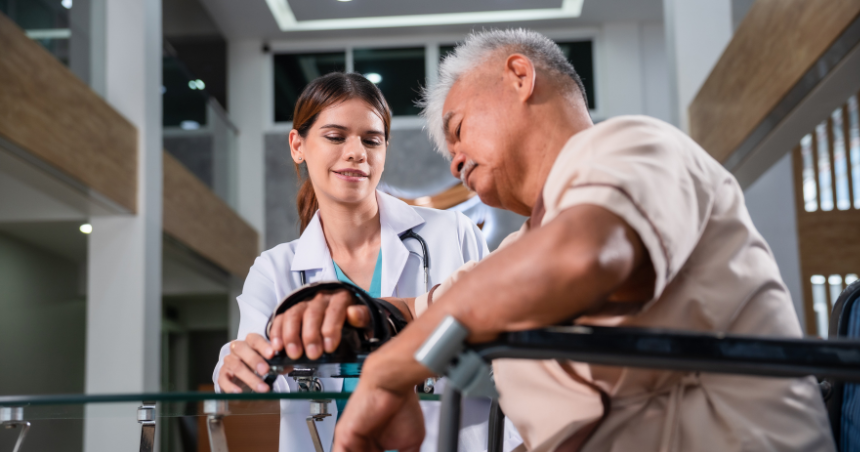Stroke rehabilitation helps people who’ve had a stroke regain their independence and abilities. It may include physical therapy, speech therapy, or occupational therapy.
The time it takes for rehabilitation can be different for each person – it might last weeks, months, or even years. While some people recover fully, others may face long-term challenges.
This article explains some common changes after a stroke and the purpose of stroke rehabilitation. It also provides information on support for caregivers.
Why are the First 90 Days So Crucial?
According to the American Stroke Association, the first 90 days after a stroke are extremely important for recovery. During this time, the brain has a high ability to form new connections and learn things more easily, known as neuroplasticity. This helps a lot with recovery.
After around 3 months, the brain’s neuroplasticity returns to a typical level. Recovery is still possible after this, but progress will be slower.
Where Does Rehabilitation Take Place?
Stroke rehabilitation usually starts in the hospital. After that, a person will continue receiving rehabilitation in one of the following settings, based on their individual needs:
- A hospital’s inpatient rehabilitation unit
- A subacute care unit
- A long-term care facility offering rehabilitation therapy and specialized nursing care
- A specialized rehabilitation hospital offering individualized inpatient therapy
- At home, involving outpatient care
What Does Rehabilitation Involve?
Stroke rehabilitation is a program of therapies that helps a person recover from a stroke and regain as much independence as possible.
According to the Centers for Disease Control and Prevention, stroke survivors typically begin rehabilitation within the first couple of days after a stroke and continue the program after leaving the hospital.
Therapists will assess a person’s rehabilitation needs following a stroke.
Stroke rehabilitation typically includes the following approaches:
Physical Therapy
Physical therapy aims to improve a person’s movement, address any pain, and prevent further physical problems.
A physical therapist will help a person relearn simple motor activities like moving from the bed to a chair, walking, and lying down.
They can also fit people with braces, if needed, and teach them how to use mobility devices such as wheelchairs, canes, or walkers.
A physical therapist will recommend exercises to do and how often, to get stronger. As a person regains strength, these exercises may feel easier, and the physical therapist can introduce new challenges and exercises.
Speech Therapy
A speech therapist helps people improve their communication skills after a stroke.
People may experience the following communication problems:
- Aphasia: This refers to difficulties with coordinating and understanding speech. The symptoms vary widely, and around one-third of stroke survivors experience it.
- Dysarthria: This involves problems controlling the muscles in the face, mouth, and throat, leading to slurred, slow, or quiet speech.
- Apraxia of Speech: This occurs when a person cannot move their mouth muscles in the correct order to produce normal speech.
A speech therapist may teach compensation strategies, such as using gestures or electronic devices, to help people express themselves after a stroke.
Speech therapy usually begins in the hospital and continues once a person returns home. To improve, people should practice communicating as much as possible.
Occupational Therapy
Occupational therapy helps people regain the skills needed for independent daily living. An occupational therapist can:
- Share strategies for daily tasks like cooking, showering, and household chores
- Adapt activities to make them easier
- Provide aids and equipment to assist with daily tasks
- Advise on home or workplace modifications to promote independence
- Teach caregivers how to best support someone after a stroke
An occupational therapist can help rebuild confidence in important life activities. With practice, tasks will likely become easier, allowing for new challenges.
Tips for Stroke Recovery
The British Heart Foundation offers these tips for stroke recovery:
- Gradually Build Strength: Increase exercise and activity limits bit by bit without overdoing it. Set personal goals without comparing to others.
- Focus on Progress: Stroke rehab can be lengthy and challenging. Celebrate small improvements to stay motivated.
- Seek Support: Recovery requires time and effort. When possible, ask family and friends for help with everyday tasks.
Preventing Another Stroke
According to the American Stroke Association, 1 in 4 stroke survivors will have another stroke. However, many second strokes are preventable with lifestyle changes like:
- Managing high blood pressure
- Maintaining healthy cholesterol levels
- Controlling blood sugar
- Staying active
- Eating a healthy diet
- Maintaining a moderate weight
- Quitting smoking or vaping
In Summary
Stroke rehabilitation is a program of therapies aimed at helping people regain independence after a stroke. Depending on needs, it may involve physical, speech, psychological, and occupational therapy.
Rehabilitation typically begins in the hospital within a couple days after a stroke. It may continue at a rehabilitation center or with a therapist visiting the person’s home.
Factors that aid recovery include gradually building strength, focusing on progress, and having support from family, friends, and stroke support networks.


